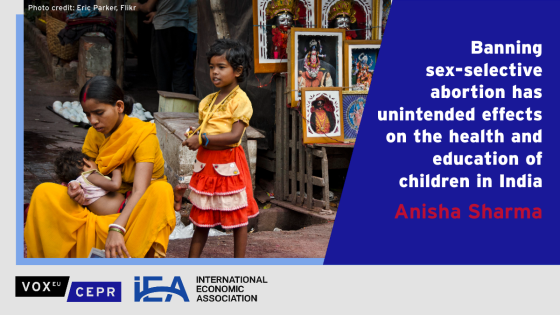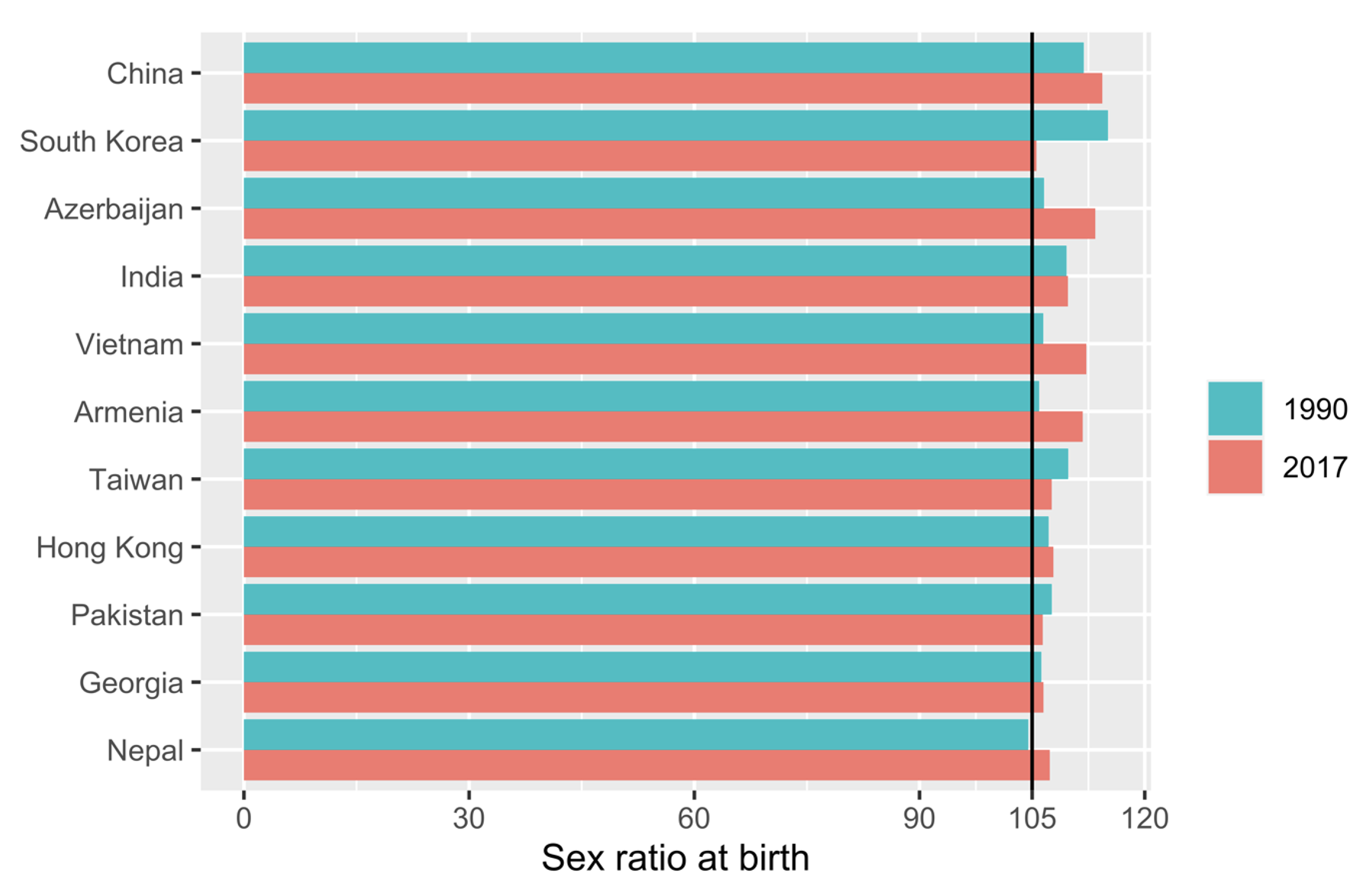One of the most egregious manifestations of gender discrimination is the phenomenon of ‘missing women’ or the presence of a strongly male-biased sex ratio (Sen 1992). In regions with strong cultural preferences for sons, male-biased sex ratios stem from the widespread practice of prenatal sex-selection, female infanticide, and the systemic neglect of female health and nutrition (Anderson and Ray, 2015 2019, Bongaarts and Guilmoto 2015, Chao et al. 2019). Governments in severely affected countries such as India and China have enacted laws to curb sex-selective abortions to correct the skewed gender balance (Das Gupta, 2019). However, where such measures fail to shift social norms of son preference, they can have the unintended consequence of redirecting gender discrimination towards other aspects of child-rearing (Goodkind 1996).
In this column, I investigate the repercussions of prohibiting sex-selective abortions on parental investments in their children’s human capital. I focus here on results from two recent papers that examine investments in education (Rastogi and Sharma 2022) and investments in health (Dasgupta and Sharma 2023a). A successful ban on sex-selective abortions should lead to an increase in female births, which can then influence human capital outcomes in various ways. First, an increase in the number of ‘unwanted’ female births could lead to a worsening of discrimination against them. Second, parents may resort to fertility stopping behaviour, where they keep having children until they achieve a desired number of sons. Increasing fertility can hurt all children born into larger families through an increase in sibling competition for parental resources and may disproportionately hurt girls who are more likely to be born into larger families. Third, a relative increase in female births could eventually lead to increased competition over potential male spouses in the marriage market, leading parents to increase investments in the human capital of their daughters to make them a better match. The net impact on gender gaps in human capital investments is therefore ambiguous.
The introduction of sex determination and abortion technology to India in the 1980s triggered a seismic shift in the nation's demographic landscape, with an estimated 480,000 female foetuses being aborted every year between 1995 and 2005 (Bhalotra and Cochrane 2010). Consequently, the child sex ratio in India declined sharply, plummeting from 964 girls per 1,000 boys in 1971 to 914 girls per 1,000 boys in 2011. In response to these alarming imbalances, the Indian Parliament passed the Pre-Conception and Pre-Natal Diagnostics Techniques Act (the PNDT Act) in 1994. The PNDT Act aimed to curb female foeticide by prohibiting and criminalising both prenatal diagnostic methods for sex-determination as well as sex-selective abortions, with hefty prison sentences and fines sanctioned for violators.
Figure 1 Missing girls at birth, 1990–2017
A sex ratio at birth of 105 is the natural sex ratio expected by the World Health Organization
Source: Data from Chao et al. (2019) via Our World in Data.
Impact of the ban on sex-selective abortions on female births
We first examine the impact of the ban on female births. Bhalotra and Cochrane (2010) had previously identified that sex-selective abortions typically did not take place at the first birth order; instead, they were substantially more likely to take place at higher birth orders after the birth of a daughter. We document this in our data as well: while the bans did not change the sex of the firstborn child, it did increase the probability of a female birth in families with firstborn daughters, relative to those with firstborn sons. Our results are robust to using a mother fixed effects specification where we analyse mothers whose fertility spanned the period of the ban, showing that mothers to firstborn females were more likely to have a female child after the ban was introduced, compared to mothers to firstborn males. Many of these additional female births were concentrated in relatively poor and rural families, which were likely to have been those who could not afford access to illegal ultrasounds and abortions at private clinics.
Given these facts, we follow Anukriti et al. (2022) in identifying firstborn female families as being intensively treated by the ban, compared to firstborn male families, and we use the quasi-exogenous variation in the sex of the firstborn child to identify the causal effects of the ban on child health and education. We additionally use variation in the timing of the ban across different Indian states to identify its impact on human capital attainment.
Impact of the ban on educational and health outcomes
Among health outcomes, we find that exposure to the ban on prenatal sex selection led to a 25% increase in child mortality among firstborn female families, relative to firstborn male families. At the same time, health investments by parents of firstborn females in their children declined, particularly ante-natal visits by a pregnant mother to a clinic, vaccine take-up for pregnant women and their children and duration of breastfeeding. We additionally find evidence of rising fertility in firstborn female families. Taken together, the evidence suggests that in the absence of access to sex-selective abortions, families with firstborn females resorted to fertility stopping behaviour, leading to more siblings. This inevitably leads to a fall in parental investments made in children in these families. Interestingly, we do not find evidence of an increasing gender gap in health outcomes within firstborn female families, suggesting that the channel of outright discrimination against unwanted daughters plays a less important role here. However, the gender gap in health outcomes across all family types does worsen, as girls are more likely to be born into larger and poorer families, with lower health investments per child.
Among educational outcomes as well, we find evidence of widening gender disparities, with girls exposed to the policy becoming 2.3, 3.5, and 3.2 percentage points less likely than boys to complete grade 10, grade 12, and enter university, respectively. Again, this is driven by the disproportionate birth of girls into families that were intensively treated by the ban: households that are poor and rural. Unlike in the case of health investments, we do find a widening of the gender gap in educational outcomes within firstborn female families as well: girls in such families are 4.2 percentage points less likely to enter university than boys in such families, pointing to the possibility of increasing discrimination against daughters, at least in terms of educational investments.
We find that the ban does have marriage market effects as well. Women exposed to the ban marry at an older age and are more likely to be employed, suggesting that they face increased competition in the marriage market for a spouse. To the extent that their parents may also be increasing investments in their human capital to increase the chances of an improved match, our estimated effects of the ban are an underestimate of the true impact of the ban.
The way forward for policy
Governments across Asia have frequently resorted to top-down legislative changes to effect social transformations – such as gender-progressive reforms of inheritance laws or bans on dowry – but these have been found to have mixed results, often leading to increase gender discrimination on alternate margins (Bhalotra et al. 2018, Rosenblum 2015, Shenk 2007).
Our results suggest that there are similar adverse consequences that emerge from a ban on sex-selective abortions. Without shifts in the social norms around son preference, bans on abortions can simply displace gender discrimination to a postnatal margin, where it will show up in increased gender gaps in health and education. Moreover, restrictions on abortions of any kind will likely have negative consequences for maternal health (Clarke and Mühlrad 2018, 2021).
On the other hand, policy interventions that focus on shifting the demand for daughters by directly addressing regressive gender norms can have positive effects (see Dasgupta and Sharma 2022 for a review of the policy responses). One such policy is the Beti Bachao, Beti Padhao (Save Daughters, Educate Daughters) programme, implemented in India between 2015-19. This intervention included a mass media campaign rolled out through television, radio, and social media that was designed to shift people’s perceptions about the value of a daughter, while simultaneously increasing policing of illegal sex-selective abortions. We analyse this policy in another paper (Dasgupta and Sharma 2023b), and find that it led to an increase in female births, while also leading to a reduction in the gender gap in mortality outcomes within a year of birth. The declining gender gap in mortality is driven by declining mortality of girls born into firstborn female families. We also document an increase in breastfeeding and immunization of girls, compared to boys, in such families. Policies like these suggest the way forward: that bans and punitive action against discriminatory behaviour must be accompanied with interventions that seek to shift regressive social norms.
Editors' note: This column is published in collaboration with the International Economic Associations’ Women in Leadership in Economics initiative, which aims to enhance the role of women in economics through research, building partnerships, and amplifying voices.
References
Anderson, S and D Ray (2015), “Missing unmarried women”, VoxEU.org, 10 October.
Anderson, S and D Ray (2019), “Missing unmarried women”, Journal of the European Economic Association 17(5): 1585– 1616.
Anukriti, S, S Bhalotra and E H Tam (2022), “On the quantity and quality of girls: Fertility, parental investments and mortality”, The Economic Journal 132(641): 1–36.
Bhalotra, S, R Brulé and S Roy (2020), “Women’s inheritance rights reform and the preference for sons in India”, Journal of Development Economics 146: 1–15.
Bhalotra, S R and T Cochrane (2010), “Where have all the young girls gone? Identification of sex selection in India”, IZA Discussion Paper 5381.
Bongaarts, J and C Z Guilmoto (2015), “How many more missing women? Excess female mortality and prenatal sex selection, 1970–2050”, Population and Development Review 41(2): 241–269.
Chao, F, P Gerland, A R Cook and L Alkema (2019), “Systematic assessment of the sex ratio at birth for all countries and estimation of national imbalances and regional reference levels”, Proceedings of the National Academy of Sciences 116(19): 9303–9311
Das Gupta, M (2019), “Is banning sex-selection the best approach for reducing prenatal discrimination?”, Asian Population Studies 15(3): 319–336
Dasgupta, A and A Sharma (2022), “Missing women: A review of underlying causes and policy responses”, Oxford Research Encyclopaedia of Economics and Finance.
Dasgupta, A and A Sharma (2023a), "How does a ban on sex-selective abortions affect child health?", forthcoming in Health Economics.
Dasgupta, A and A Sharma (2023b), " Shifting gendered social norms: Impact of a mass media campaign on child health in India", forthcoming in Journal of Development Studies.
Goodkind, D (1996), “On substituting sex preference strategies in East Asia: does prenatal sex selection reduce postnatal discrimination?”, Population and Development Review 22(1): 111–125.
Clarke, D and H Mühlrad (2018), “Abortion laws and women’s health”, VoxEU.org, 12 November.
Clarke, D and H Mühlrad (2021), “Abortion laws and women’s health”, Journal of Health Economics 76: 102413.
Rastogi, G and A Sharma (2022), "Unwanted daughters: the unintended consequences of a ban on sex-selective abortions on the educational attainment of women", Journal of Population Economics 35 (4): 1473-1516.
Rosenblum, D (2015), “Unintended consequences of women’s inheritance rights on female mortality in India”, Economic Development and Cultural Change 63(2): 223–248.
Shenk, M K (2007), “Dowry and public policy in contemporary India”, Human Nature 18(3): 242–263.


